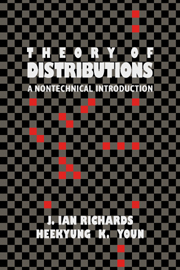Book contents
- Frontmatter
- Contents
- Preface
- 1 Introduction
- 2 The elements of distribution theory
- 3 Examples of distributions
- 4 Fourier transforms
- 5 Tempered distributions
- 6 Extension to higher dimensions
- 7 A general definition of multiplication and convolution for distributions
- Appendix 1 Partitions of unity
- Appendix 2 The Structure Theorem
- Appendix 3 Proof of Theorems A and B from Chapter 7
- Bibliography
- Index
5 - Tempered distributions
Published online by Cambridge University Press: 06 January 2010
- Frontmatter
- Contents
- Preface
- 1 Introduction
- 2 The elements of distribution theory
- 3 Examples of distributions
- 4 Fourier transforms
- 5 Tempered distributions
- 6 Extension to higher dimensions
- 7 A general definition of multiplication and convolution for distributions
- Appendix 1 Partitions of unity
- Appendix 2 The Structure Theorem
- Appendix 3 Proof of Theorems A and B from Chapter 7
- Bibliography
- Index
Summary
The tempered distributions are a subset of the set of all distributions. For clarity, we shall refer to the latter as general distributions. The motive for introducing tempered distributions is that they behave particularly well with respect to the Fourier transform.
As was already suggested in the preceding chapter, the Fourier Inversion Theorem is the foundation of Fourier transform theory. Obviously one wants to have this theorem in as general a form as possible. Quite simply, this allows calculations to be performed without a continual ‘stop and think’ hesitation each time the Fourier Inversion Theorem is invoked. It is our considered judgment that no previous theory has achieved the degree of elegance and generality that the theory of tempered distributions has. The problem was not that the facts were unknown – they have been known for a long time – but there was always a certain awkwardness in their presentation. To show the nature of the difficulties, we shall glance briefly at one of the earlier presentations – that based on L1 (integrable) functions. Since the Fourier transform is given by an integral, (t) = ∫∞–∞ e–2πitxf(x) dx, it is natural to require that this integral converge, and this in turn requires the integrability of the function f(x). Where is the trouble? Well, the Fourier transform F(t) is not necessarily integrable. Hence the Fourier Inversion Theorem (which asserts that f(x) is the inverse Fourier transform of F(t)) becomes meaningless. Actually, it can be given a meaning, but special – and rather ad hoc – methods are necessary to salvage it. With the theory of tempered distributions, all of these difficulties disappear.
- Type
- Chapter
- Information
- The Theory of DistributionsA Nontechnical Introduction, pp. 58 - 88Publisher: Cambridge University PressPrint publication year: 1990



